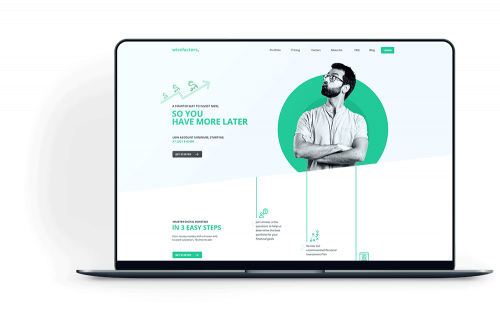The Ultimate Overview to Creating Effective and Engaging Web Design
Wiki Article
A Thorough Overview of the most effective Practices in Website Design for Producing Navigable and user-friendly Online Platforms
The efficiency of an online platform hinges considerably on its design, which must not just bring in users but also guide them flawlessly with their experience. Recognizing these principles is essential for designers and designers alike, as they straight impact customer satisfaction and retention.Comprehending Customer Experience
Comprehending individual experience (UX) is critical in website design, as it directly influences how visitors communicate with a website. A well-designed UX ensures that individuals can browse a website intuitively, accessibility the details they seek, and total desired activities, such as signing or making an acquisition up for a newsletter.Crucial element of effective UX style include use, accessibility, and looks. Functionality focuses on the convenience with which customers can accomplish tasks on the site. This can be accomplished through clear navigating frameworks, sensible material company, and responsive comments mechanisms. Ease of access makes sure that all users, including those with impairments, can connect with the site properly. This includes adhering to developed standards, such as the Web Material Access Standards (WCAG)
Aesthetics play an important duty in UX, as visually appealing designs can enhance user contentment and engagement. Color pattern, typography, and images needs to be attentively chosen to produce a cohesive brand name identity while additionally helping with readability and understanding.
Ultimately, focusing on customer experience in website design fosters greater individual complete satisfaction, motivates repeat gos to, and can substantially boost conversion prices, making it an essential aspect of successful electronic techniques. (web design)
Value of Responsive Style
Responsive style is a vital part of contemporary internet development, ensuring that internet sites offer an optimal watching experience across a variety of tools, from desktop computers to smart devices. As customer actions significantly changes towards mobile browsing, the need for web sites to adapt effortlessly to various screen dimensions has actually come to be paramount. This adaptability not only enhances use but additionally substantially influences individual interaction and retention.
A receptive design employs fluid grids, flexible images, and media queries, permitting for a natural experience that preserves performance and aesthetic honesty no matter of device. This technique gets rid of the requirement for individuals to focus or scroll flat, causing a much more user-friendly interaction with the content.
In addition, online search engine, especially Google, focus on mobile-friendly sites in their positions, making responsive layout necessary for keeping exposure and access. By adopting receptive style concepts, services can get to a wider target market and boost conversion rates, as individuals are most likely to engage with a site that offers a consistent and smooth experience. Ultimately, responsive layout is not merely an aesthetic option; it is a strategic requirement that mirrors a commitment to user-centered style in today's digital landscape.
Simplifying Navigating Frameworks
A well-structured navigation system is crucial for improving the individual experience on any type of web site. Streamlining navigating frameworks not just help customers in discovering info promptly however also fosters engagement and lowers bounce rates. To attain this, internet designers must prioritize quality through using uncomplicated labels and categories that show the web content properly.
Integrating a search function additionally enhances use, enabling individuals to locate material straight. Furthermore, carrying out breadcrumb tracks can offer customers with context concerning their place within the website, promoting convenience of navigating.
Mobile optimization is an additional important aspect; navigating needs click resources to be touch-friendly, with plainly defined buttons and web links to suit smaller displays. By reducing the variety of clicks required to access web content and guaranteeing that navigating is regular throughout all pages, designers can create a smooth individual experience that motivates exploration and minimizes disappointment.
Focusing On Availability Specifications
Roughly 15% of the worldwide populace experiences some kind of special needs, making it crucial for web designers to prioritize ease of access standards in their tasks. Availability incorporates different facets, consisting of aesthetic, acoustic, cognitive, and motor impairments. By adhering to established standards, such as the Internet Content Ease Of Access Guidelines (WCAG), developers can create comprehensive digital experiences that cater to all individuals.One fundamental method is to make sure that all web content is perceivable. This includes offering alternative text for photos and ensuring that videos have records or subtitles. In addition, keyboard navigability is essential, as lots of individuals rely on keyboard shortcuts as opposed to computer mouse interactions.
 Additionally, color contrast should be thoroughly taken into consideration to suit people with visual disabilities, guaranteeing that message is understandable versus its background. When making types, tags and mistake messages must be descriptive and clear to assist individuals in finishing tasks successfully.
Additionally, color contrast should be thoroughly taken into consideration to suit people with visual disabilities, guaranteeing that message is understandable versus its background. When making types, tags and mistake messages must be descriptive and clear to assist individuals in finishing tasks successfully.Lastly, carrying out usability screening with people who have impairments can provide very useful understandings - web design. By prioritizing access, internet designers not only abide with legal standards yet additionally broaden their target market reach, promoting a more inclusive online environment. This dedication to access is necessary for a easy to use and really accessible internet experience
Utilizing Visual Power Structure
Clearness in layout is vital, and utilizing visual pecking order plays an essential function in accomplishing it. Aesthetic power structure describes next page the arrangement and discussion of aspects in a method that plainly shows their significance and guides user interest. By strategically using size, comparison, shade, and spacing, designers can develop a natural circulation that routes customers via the material flawlessly.Using bigger typefaces for headings and smaller sized ones for body message develops a clear distinction between areas. In addition, using strong shades or contrasting backgrounds can accentuate vital info, such as call-to-action buttons. White area is just as important; it aids to stay clear of clutter and enables great post to read individuals to concentrate on the most essential aspects, boosting readability and total user experience.
One more trick element of aesthetic pecking order is making use of imagery. Relevant photos can enhance understanding and retention of details while additionally separating text to make material much more digestible. Inevitably, a well-executed visual power structure not only improves navigating yet also fosters an user-friendly interaction with the internet site, making it most likely for customers to achieve their goals effectively.
Verdict

In recap, adherence to best techniques in website design is essential for developing navigable and intuitive on-line platforms. Emphasizing receptive design, streamlined navigation, and ease of access requirements fosters a comprehensive and straightforward atmosphere. Additionally, the reliable use aesthetic power structure improves user interaction and readability. By prioritizing these components, internet developers can dramatically boost individual experience, guaranteeing that online platforms fulfill the varied needs of all individuals while facilitating effective interaction and complete satisfaction.
The effectiveness of an online system pivots considerably on its layout, which must not only attract users yet additionally lead them perfectly via their experience. By embracing receptive style principles, services can reach a broader target market and enhance conversion rates, as individuals are more likely to involve with a website that provides a consistent and smooth experience. By adhering to developed standards, such as the Internet Material Access Standards (WCAG), designers can produce comprehensive digital experiences that cater to all users.
White room is equally important; it helps to prevent mess and enables customers to focus on the most crucial aspects, improving readability and overall user experience.
By prioritizing these aspects, internet designers can considerably enhance individual experience, ensuring that on the internet platforms satisfy the varied needs of all customers while promoting reliable communication and satisfaction.
Report this wiki page